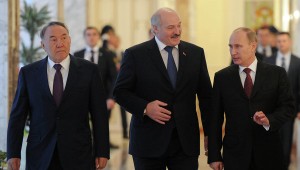 ASTANA, May 22 – The presidents of Kazakhstan, Russia and Belarus are expected to sign a treaty on the establishment of the Eurasian Economic Union (EEU) here on May 29. The agreement is expected to come into force on Jan. 1, 2015.
ASTANA, May 22 – The presidents of Kazakhstan, Russia and Belarus are expected to sign a treaty on the establishment of the Eurasian Economic Union (EEU) here on May 29. The agreement is expected to come into force on Jan. 1, 2015.
In general, according to experts, the perception of the Customs Union and Single Economic Space amongst the populations of their member states is by and large positive.
Still, there is skepticism in the post-Soviet space about the future Eurasian Economic Union that mirrors the doubts that once surrounded the European Union. It may seem as if the public and business and expert communities are becoming less enthusiastic about the potential of these pan-Eurasian projects, but skepticism is normal in any project. Skepticism will naturally continue to haunt Eurasian integration projects until each individual personally feels their benefits.
A panel titled “Public Perception of Eurasian Integration,” organised by the Centre for Integration Studies of the Eurasian Development Bank and the Public Opinion Research Institute, which took place on the sidelines of the Seventh Astana Economic Forum on May 21, focused on the problems of public and elite perception of integration and cooperation amongst CIS member states in economic, political, social and cultural areas.
The event brought together experts on and researchers of integration processes including Valery Fyodorov, general director of the Russian Public Opinion Research Center (Moscow, Russia), Igor Zadorin, executive director of the International Research Agency Eurasian Monitor (Moscow, Russia), Svetlana Kozhirova, professor in the International Relations Department of Lev Gumilyov Eurasian National University (Astana, Kazakhstan,)Botagoz Rakisheva of the Public Opinion Research Institute, Evgeny Vinokourov, director of the Centre for Integration Studies of the Eurasian Development Bank, Aigul Sadvokasova of the Centre for the Study of Interethnic and Interfaith Relations of the Academy of Public Administration under the President of Kazakhstan (Astana, Kazakhstan), Vladimir Pereboyev, department head of the Centre for Integration Studies of the Eurasian Development Bank (EDB CIS,)as well as many other officials from government and international organisations.
“Eurasian integration is difficult to imagine in isolation from public perception and popular support. Eurasian integration projects should be aimed at improving the welfare of citizens as individuals,” Pereboyev said.
“It is very important to pay attention to public perception and how integration projects are understood by the population, business executives and politicians,” he continued.
The EDB Centre for Integration Studies project, the EDB Integration Barometer, is meant to be a long-term institution that clearly presents the results of a comprehensive research study on public attitudes towards integration in the CIS region. It is based on yearly monitoring surveys of public opinion in 12 CIS states and focuses on a diverse range of issues, such as multilateral economic cooperation, interstate political relations, social and business contacts and cultural interactions. One of the key goals of the project is to study public support for the Customs Union and the Single Economic Space (the future Eurasian Economic Union,) by not only examining the three member countries, but also the entire region.
According to the 2013 EDB Integration Barometer report, “In Kazakhstan, Russia and Belarus, public support for the Customs Union and the Single Economic Space (SES) remains high at 73 percent, 67 percent and 65 percent respectively,” based on the second survey of public preferences in the CIS regarding various issues of Eurasian integration undertaken by the Eurasian Development Bank’s (EDB) Centre for Integration Studies and Eurasian Monitor. More than 14,000 people in 11 CIS countries and Georgia were polled, which translates to 1,000 to 2,000 in each country.”
“In comparison to 2012, the 2013 survey shows that public support for the Customs Union and the SES shrank by 7 percent in Kazakhstan and by 5 percent in Russia. This happened largely because of the increase in the number of respondents who stated that they were indifferent to their country’s participation in the Customs Union and SES. In Belarus, the level of support for membership increased from 60 percent to 65 percent,” the report states.
There is no doubt that Kazakhstan has always played a significant role in many Eurasian integration efforts. Kazakhstan initiated the Congress of Leaders of World and Traditional Religions, the Conference on Interaction and Confidence-Building Measures in Asia (CICA) and just recently, President Nursultan Nazarbayev of Kazakhstan proposed the formation of the Organisation for Security and Development in Asia, an Asian analogue to the OSCE, based on CICA.
Eurasian integration is being implemented upon President Nazarbayev’s initiative that he put forward during a speech at Moscow State University in March 1994. The concept itself is seen as a mutually beneficial union of mutually respectful partners.
Officials are keen to stress that the future union is not about the reincarnation of any past political union, including the Soviet Union. President Nazarbayev emphasises that Eurasian integration is a way to fight the challenges of the third global industrial revolution. According to him, the Eurasian Economic Union should be a self-sufficient regional financial institution, which will be a part of a new global financial system designed to help mitigate the effects of the global crisis. At the same time, President Nazarbayev points out that Kazakhstan, Russia and Belarus remain independent nations with their own national interests and any suspicions surrounding the true goals of the Eurasian integration process are groundless.


